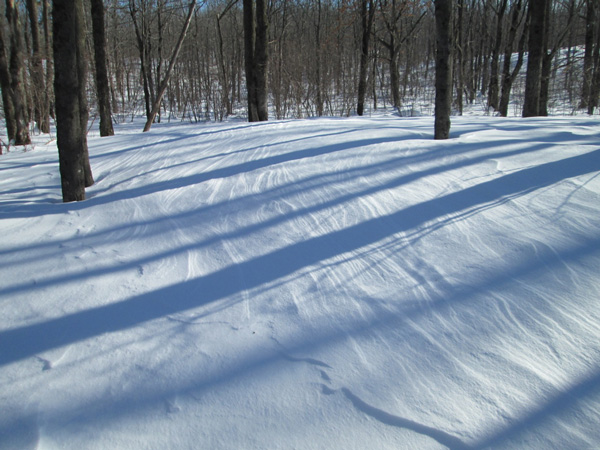News & Articles
Browse all content by date.

The forest is quiet and still. Overnight, our first snow transformed the woods from a sepia tone landscape to a black and white photo. Looking up, the lacy pattern of twigs embosses a network across the sky. When an icy shard catches me in the eye, I look back down, and am struck by the contrast. At the level of the forest floor, each trunk stands stoically alone, separated from its neighbors by a barren expanse of white.
The reality is quite the opposite. At the level of twigs, trees are separate. To avoid competition for sunlight, they tend to grow away from one another, each seeking their own personal bubble. Occasionally, two trunks or two branches will miscalculate and intersect to squeak in the wind, or groan as scar tissue melds them together until death do they part. The real connections, though, happen beneath the duff—almost beneath our notice.
Unlike the twigs, who studiously pretend to ignore each other unless forced to mingle, the miles of roots intersect regularly underground in their search for water and nutrients. When roots of the same or closely related species meet under the right conditions, they fuse together. This grafting requires that tree roots be sufficiently large; be in prolonged contact with each other under pressure that crushes their “skin”; and have sufficient moisture. Once the subterranean stars align, the grafted roots can transfer sugars, water, minerals, and chemical signals from tree to tree.
According to German forester Peter Wohlleben, in his book The Hidden Life of Trees, “most individual trees of the same species growing in the same stand are connected to each other through their root systems.”
This connectivity creates stability for the forest at many levels. On a physical level, the interwoven tangle of roots provides stability in windstorms. Imagine yourself alone, feet tight together, being pushed. Either you fall over, or your “trunk” splits and you step forward for stability. If you stand with a wide base, or link limbs with friends, you can withstand more force. As trees toss in a gale, their own spreading roots provide a stable base. But it doesn’t stop there. Their roots are connected to their neighbors’ roots, and their collective base is as wide as the entire forest.
That entire forest is important. Together, all the trees create a microclimate: their very own ecosystem that buffers wind, stays cooler in the summer, and holds moisture at multiple levels. This microclimate is so important that it might even be worthwhile for well-located trees—those with ample access to water, nutrients, and sunlight—to redistribute those resources among weaker trees and prolong their lives. The partnership would serve to maintain stand integrity against pests, disease, and disruption of the microclimate. It might also maximize use of resources by allowing all trees to grow at an ideal rate, instead of having a few wealthy trees hoard resources they can’t immediately use while weaker trees slow their growth in response to scarcity. The network of grafted roots facilitates that sharing.
This cooperative community of the grafted root network might confer several additional benefits on its members. For one, it is mostly trees of the same (or sometimes closely related) species that graft at their roots. This means that when stronger trees help weaker ones, they are still focusing on the survival of their own species. The resulting healthy neighbors may become a source of genetic diversity when pollen flies in spring. In addition, by helping weaker neighbors, the stronger trees maintain an “enemy” they know, and prevent the establishment of an unknown competitor who might eventually reduce their access to sunlight or water.
Finally, when a tree dies, its roots can persist and continue contributing to the community. This is no small inheritance in a tree’s constant search for resources. Although the orphaned roots can’t deliver sugars from their own crown anymore, they can bring up nutrients and water in exchange for maintenance by the community. We can see the result of this exchange in the existence of living stumps. Although not every stump will continue to grow, I have occasionally observed new scar tissue forming on the cut surface. This is evidence that, while its crown is gone, the cut tree’s root system is still well-connected and active.
In an even more remarkable example of network support, small redwood, spruce, and balsam fir trees can be albino. Their needles are ghostly pale, and contain no chlorophyll. All their sugar, then, must come from other trees, intravenously fed through their roots.
This period between Thanksgiving and the New Year—when we open our checkbooks to share resources with those in our community who have less, and donate to organizations that we feel will support our favored microclimate—has many parallels to the forest. While we may sometimes feel like stoic individuals, an interwoven community is hidden just out of sight.
Special Note: Emily’s book, Natural Connections: Exploring Northwoods Nature through Science and Your Senses is here! Order your copy at http://cablemuseum.org/natural-connections-book/.
For over 45 years, the Cable Natural History Museum has served to connect you to the Northwoods. Come visit us in Cable, WI! Our new phenology exhibit: “Nature’s Calendar: Signs of the Seasons” is now open.
| Tweet |


